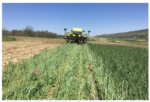Advertise Follow Us
Items Tagged with 'Cover crop termination'
ARTICLES
No-Till, Cover Crops Pay Dividends on Dairy Farm
A pursuit of economical cattle feed leads to full-blown adoption of a diversified no-till, cover crop system.
Read More
Rolling Covers, Planting Non-GMOs ‘Green’ Leads to Efficient, Thriving No-Till System
By relying on good farm data to improve their operation, Rick Clark and family are capitalizing on the non-GMO crop market while cutting costs, building soil health and stabilizing yields.
Read More










